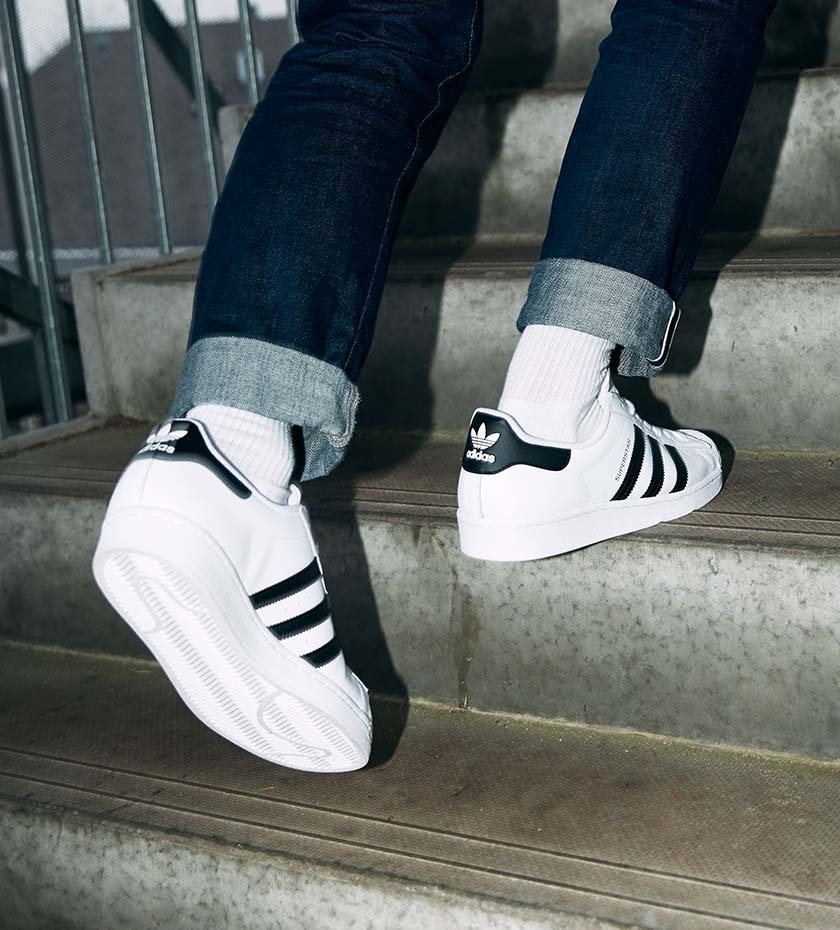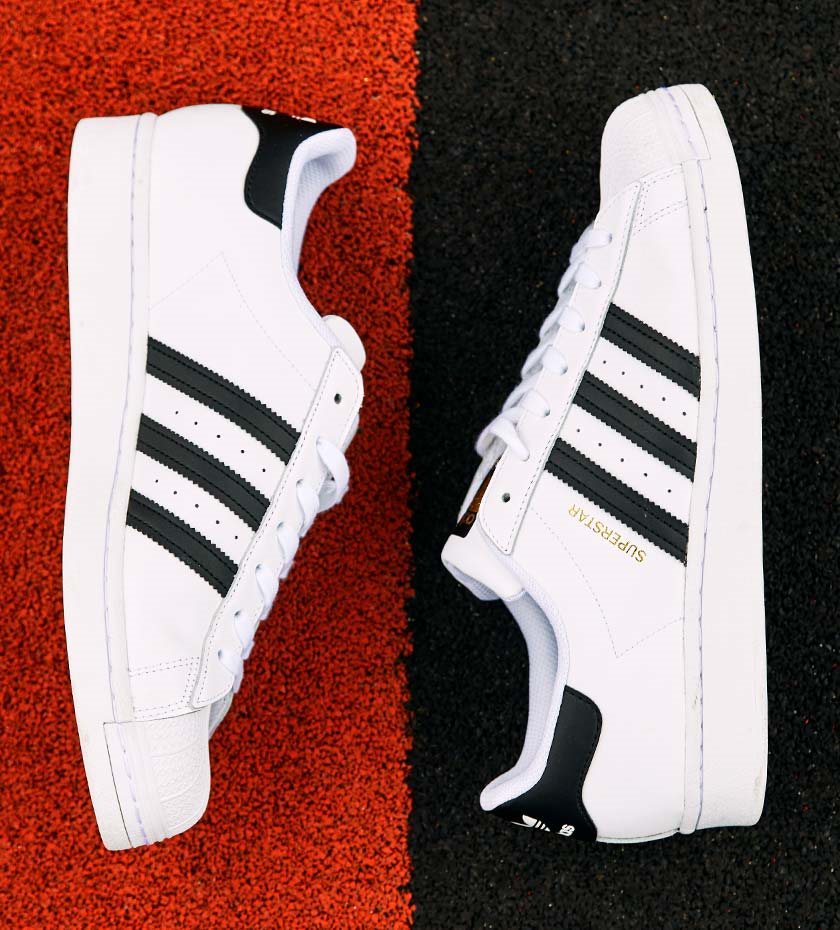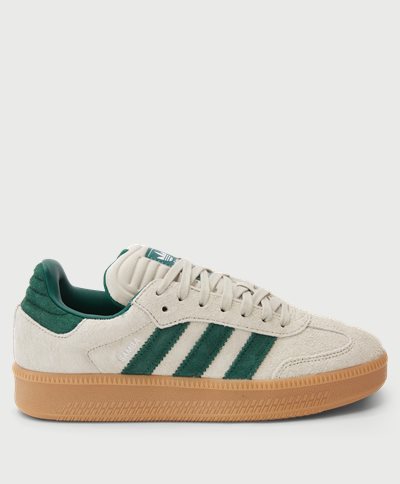The full story behind the iconis Adidas Superstar

Adidas Superstar and the fight with Converse
Long before Run-DMC filled arenas and concert venues in their famous Adidas tracksuits and leather Superstars, the iconic sneakers were designed for one specific purpose – to revolutionise the world of basketball.
The Adidas Superstar sneaker as we know it today, owes much of its popularity to the Adidas Supergrip. Adidas Supergrip was created in 1965, four years before the Adidas Superstar was launched. The Supergrip model reportedly represented Adidas’ first steps in their efforts to achieve success in the basketball world.
The previous Supergrip models did not focus on a reinforced and robust front, but a new group of innovative employees at Adidas, suddenly saw prospects in taking some of the improvements they had made to sports shoes like tennis shoes and football boots, and incorporating them in a basketball shoe. Implementing a reinforced and robust front on the shoe allowed the wearer to make much more efficient start-stop movements – a great advantage on the basketball court. Adidas Supergrip paved the way for the establishment of Adidas Superstar. Even though Adidas had now developed a shoe that could revolutionise the world of basketball, they still faced a serious challenge – the competition was fierce.


Broken ankles and damaged knees – an obvious business opportunity
When Adidas launched the Superstar model in 1969, the market for basketball shoes was dominated by the brand Converse. Their high-top model “Converse All Star”, was the preferred shoe among amateur and professional basketball players alike. Converse had conquered the sports world with a canvas shoe, which seems almost unthinkable today. The market for basketball shoes hungered for innovation because Converse had dominated the market for several years without any competition. Chris Severn, a former consultant for Adidas, noticed this and saw a business opportunity.
The Converse canvas shoe tended to stick, which was the cause of many ankle and knee injuries when basketball players made those necessary sharp turns and changes in direction. This caused Chris Severn and his design team to think in new ways. Shortly afterwards, they started to design a shoe with an upper made of leather instead of canvas. The leather upper would ensure better protection and a much better grip on the surface. The new shoe would also have a new, robust front and the three famous Adidas stripes on the side.
However, Converse had a large pool of sellers, who promoted the canvas shoe, some of whom were former basketball players, and this made them difficult to compete with. But Chris Severn and his team had a plan. They visited the many basketball courts around the country and convinced basketball players to try out their newly designed shoe. Chris Severn was convinced that if the players tried the Adidas shoe, they would realise how much better it was.
In the book “Sneaker Wars”, Chris Severn states: “They had played in canvas shoes all their life. The Superstar shoe looked totally alien to them. They weren’t paid by Converse; it was just habit.”
A new epoch for Adidas
Chris Severn quickly convinced Jack McMahon, manager of the San Diego Rockets, that his team should use Superstars. Even though The Rockets were one of the worst basketball teams in the league at that point, they helped to spread the word about the new and improved basketball shoe. Every time The Rockets played a game, the shoe was shown to a brand-new audience, which created a ripple effect. Players noticed the new shoes and Chris Severn’s telephone did not stop ringing. Professional basketball players all over the country wanted to learn more about the revolutionary shoe and they wanted to own a pair.
Just two years later, in 1969, the Boston Celtics competed in Superstars and won the NBA, which marked the beginning of the shoe’s dominance in the market for several years to come. Just four years after the Superstar was launched, 85% of professional basketball players in the USA played in Adidas shoes.
This success meant that Chris Severen could convince Adidas bosses to sign contracts for professional athletes. Shortly afterwards, in 1976, Adidas signed a contract with Kareem Abdul-Jabbar, who was the league’s biggest star at that time. He became the first basketball player to sign a professional contract with Adidas.
In just a short period of time, Converse went from hero to zero, all because of the introduction of Superstar.
Find the best-looking Adidas sneakers here.
Hip-hop’s impact on Superstar’s global success
Adidas Superstar became firmly established in mainstream culture at the beginning of the 1980s. Thanks to hip hop, the shoe became the most hyped lifestyle shoe around.
In the middle of the 1980s, Run-DMC was one of the biggest hip hop groups in the world. They sold out major arenas, were the first hip hop group to sell gold and platinum albums and were nominated for a Grammy. They were also the first hip-hop group to have their music videos played on MTV, feature on the cover of Rolling Stone magazine and were the only hip-hop group that performed at the Live Aid concert in 1985.
Run-DMC were not only famous for their amazing songs, they were also famous for their groundbreaking image. Their predecessors wore leather and rock and roll fashionwear, but Run-DMC were the first rappers who dressed like the man on the street. A big part of their look was – you guessed right – based on Adidas gear.
Run-DMC promoted the famous three stripes from top to toe in their tracksuits and Superstars. The group quickly started a fashion movement. It was simple and authentic and almost immediately, hip-hop fans everywhere wore Adidas from head to toe.
Run-DMC’s song “My Adidas” cemented the sneaker’s status in popular imagination. The song created a direct relationship between Run-DMC and Adidas, which was evident in a Run-DMC concert held in Madison Square Garden. Adidas representative Angelo Anastasio had identified Run-DMC as the direct reason why there was an increase in sales, and the concert proved him right. In an interview with shoe magazine Sole Collector, Run-DMC said:
“When Run went out there during the show, ‘D, take it off your feet; hold it up. What’s those? Everybody in here, if you got adidas on, hold ‘em up,’. “So, 40,000 people in a sold-out Madison Square Garden held a sneaker up and Anastasio was like, ‘Oh my god, it’s true.’”
See the music video to Run-DMC’s “My Adidas” below.
Run-DMC were the direct reason why sales increased, but the global phenomenon was first burned into the general public’s imagination through the group’s 1987 “Together Forever” tour. Run-DMC posed in front of the Eiffel Tower in Paris, dressed in their famous black tracksuits, gold chains and Superstars without any shoelaces.
The loss of Michael Jordan and Superstar’s status today
Icon, legend and world star basketball player Michael Jordan, played in Adidas Superstars in the junior leagues before he became a major profile in the NBA. When he became a professional player, his love of Superstar meant that he was ready to sign a contract with Adidas. However, the German sports brand decided not to offer a contract for various reasons. A decision that the management at Adidas must have regretted down the years.
Michael Jordan signed a contract with their arch-rival Nike. The contract was the beginning of what proved to be the strongest, most unchallengeable collaboration between a sports star and a sports brand of recent times.
Adidas Superstar had a crucial influence on the sneaker culture we know today. This is why it is a hugely popular sneaker and sold in countless different versions. The most prominent collaborations included Rick Owens, NEIGHBORHOOD, UNDEFEATED, BAPE and of course, Run-DMC. The collaboration with rapper Pharrell Williams in 2015 once again demonstrated the sneaker’s timelessness and unending popularity, when Adidas Superstar was sold in 50 different colours.
There’s only one thing certain in life and that’s death. Apart from Adidas Superstar, which is immortal.



































